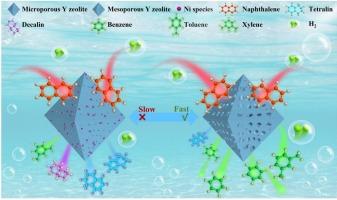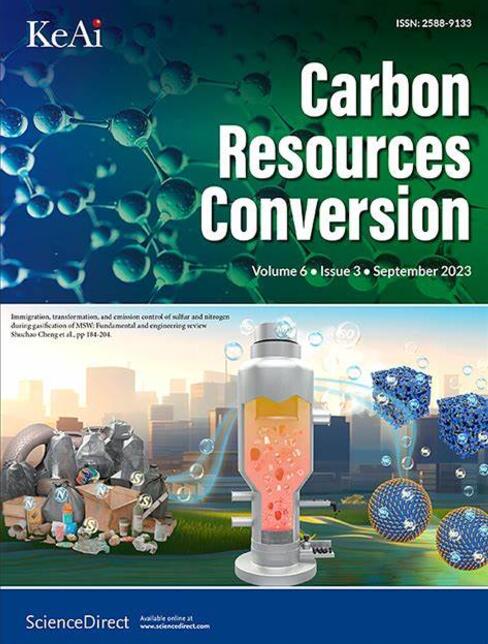Regulating metal–acid active sites in hierarchical porous Ni/Y for selective hydrocracking of naphthalene
IF 7.5
3区 环境科学与生态学
Q2 ENERGY & FUELS
引用次数: 0
Abstract
The preparation of high efficiency hydrocracking (HCK) catalyst is the key to the production of BTX (benzene, toluene and xylene) from polycyclic aromatic hydrocarbons (PAHs). In this work, the recrystallized Y zeolite (RCY) was obtained by structural reorganization of the microporous parent Y zeolite (PY), and a series of Ni/RCY catalysts with different metal–acid active sites were prepared by ethylenediamine coordination impregnation, which were used for the BTX production by hydrocracking of naphthalene. The suitable acidity and hierarchical pore structure of Ni/RCY could promote the dispersion of Ni metal, thus forming small-sized nanoparticles, which is in favor of the accessibility and diffusion of naphthalene. Besides, the electron-deficient Ni species between adjacent acid sites and metals could be generated on Ni/RCY, which could improve the metal-support interaction (MSI) and catalytic activity. Ni/RCY-4 catalyst showed the superior hydrocracking conversion (99.7 %), BTX yield (39.1 %), the reaction rate constant (k, 3.1 h−1) and turnover frequency (TOF, 16.6 h−1) of selective hydrocracking. The activation energy was lowest (64.1kJ·mol−1) among the reported catalysts in the literature. Moreover, the possible reaction mechanism of selective hydrocracking of naphthalene to BTX was further proposed.

调控分层多孔Ni/Y中金属酸活性位点对萘选择性加氢裂化的影响
制备高效加氢裂化催化剂是多环芳烃(PAHs)生产苯、甲苯和二甲苯的关键。本文通过对微孔母体Y沸石(PY)进行结构重组得到了重结晶Y沸石(RCY),并通过乙二胺配位浸渍法制备了一系列具有不同金属酸活性位点的Ni/RCY催化剂,用于萘加氢裂化生产BTX。Ni/RCY合适的酸度和分级孔结构可以促进金属镍的分散,形成小尺寸的纳米颗粒,有利于萘的可及性和扩散。此外,在Ni/RCY上,相邻的酸位和金属之间会产生缺电子的Ni,从而提高了金属-载体相互作用(MSI)和催化活性。Ni/RCY-4催化剂表现出较好的选择性加氢裂化转化率(99.7%)、BTX收率(39.1%)、反应速率常数(k, 3.1 h−1)和周转频率(TOF, 16.6 h−1)。其活化能最低,为64.1kJ·mol−1。进一步提出了萘选择性加氢裂化制BTX的可能反应机理。
本文章由计算机程序翻译,如有差异,请以英文原文为准。
求助全文
约1分钟内获得全文
求助全文
来源期刊

Carbon Resources Conversion
Materials Science-Materials Science (miscellaneous)
CiteScore
9.90
自引率
11.70%
发文量
36
审稿时长
10 weeks
期刊介绍:
Carbon Resources Conversion (CRC) publishes fundamental studies and industrial developments regarding relevant technologies aiming for the clean, efficient, value-added, and low-carbon utilization of carbon-containing resources as fuel for energy and as feedstock for materials or chemicals from, for example, fossil fuels, biomass, syngas, CO2, hydrocarbons, and organic wastes via physical, thermal, chemical, biological, and other technical methods. CRC also publishes scientific and engineering studies on resource characterization and pretreatment, carbon material innovation and production, clean technologies related to carbon resource conversion and utilization, and various process-supporting technologies, including on-line or off-line measurement and monitoring, modeling, simulations focused on safe and efficient process operation and control, and process and equipment optimization.
 求助内容:
求助内容: 应助结果提醒方式:
应助结果提醒方式:


